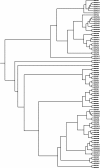Update of the human and mouse SERPIN gene superfamily
- PMID: 24172014
- PMCID: PMC3880077
- DOI: 10.1186/1479-7364-7-22
Update of the human and mouse SERPIN gene superfamily
Abstract
The serpin family comprises a structurally similar, yet functionally diverse, set of proteins. Named originally for their function as serine proteinase inhibitors, many of its members are not inhibitors but rather chaperones, involved in storage, transport, and other roles. Serpins are found in genomes of all kingdoms, with 36 human protein-coding genes and five pseudogenes. The mouse has 60 Serpin functional genes, many of which are orthologous to human SERPIN genes and some of which have expanded into multiple paralogous genes. Serpins are found in tissues throughout the body; whereas most are extracellular, there is a class of intracellular serpins. Serpins appear to have roles in inflammation, immune function, tumorigenesis, blood clotting, dementia, and cancer metastasis. Further characterization of these proteins will likely reveal potential biomarkers and therapeutic targets for disease.
Figures


References
-
- Wright HT. Introns and higher-order structure in the evolution of serpins. J Mol Evol. 1993;7:136–143. doi: 10.1007/BF00166249. - DOI
-
- Potempa J, Korzus E, Travis J. The serpin superfamily of proteinase inhibitors: structure, function, and regulation. J Biol Chem. 1994;7:15957–15960. - PubMed
-
- Silverman GA, Bird PI, Carrell RW, Church FC, Coughlin PB, Gettins PG, Irving JA, Lomas DA, Luke CJ, Moyer RW, Pemberton PA, Remold-O'Donnell E, Salvesen GS, Travis J, Whisstock JC. The serpins are an expanding superfamily of structurally similar but functionally diverse proteins: evolution, mechanism of inhibition, novel functions, and a revised nomenclature. J Biol Chem. 2001;7:33293–33296. doi: 10.1074/jbc.R100016200. - DOI - PubMed
Publication types
MeSH terms
Substances
Grants and funding
LinkOut - more resources
Full Text Sources
Other Literature Sources

